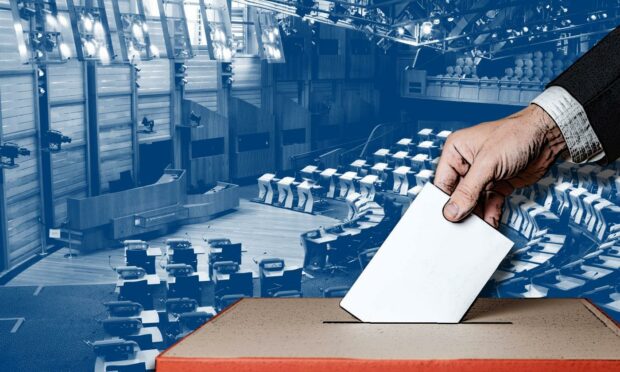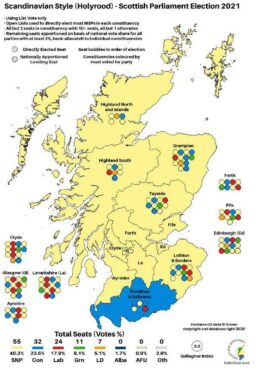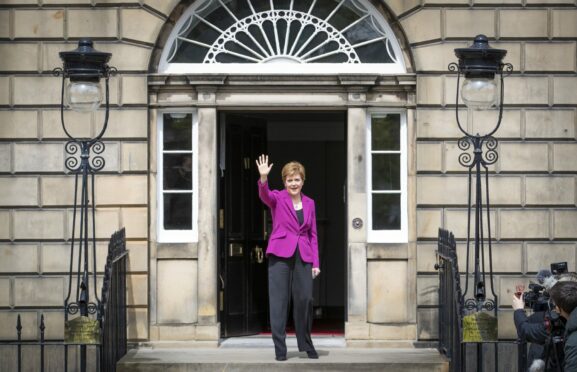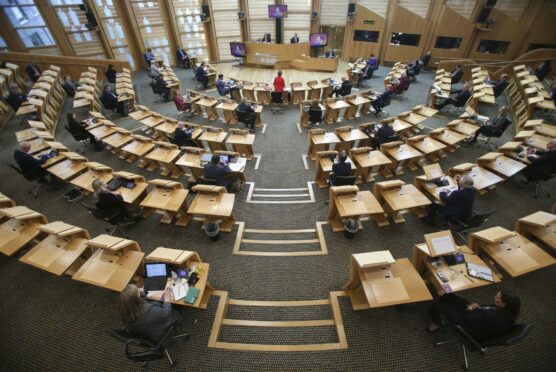Ever since devolution in 1999, Scotland has used a distinct voting system to elect MSPs to Holyrood. But is it time to change all that?
The Scottish Parliament is now being asked to grapple with the question again, through a public petition.
Campaigner Richard Wood, an Aberdeen University graduate, wants the voting system to be changed to one based on proportional representation instead of the current mix which also uses traditional first-past-the-post.
He hopes the change would make Holyrood more representative of the people it serves.
Mr Wood lodged the petition after seeing Alex Salmond’s Alba Party election campaign, which asked people to vote for them instead of the SNP in the regional lists to create an “indy supermajority” at Holyrood.
However, Alba ended up winning no seats at all.
That’s because Holyrood uses the additional member system.
How Holyrood’s system works
Voters have two ballot papers – in the first paper to elect a constituency MSP, the candidate with the most votes wins.
However once all the first votes are counted, additional MSPs are allocated to the regional seats by taking the total number of votes a party receives and dividing it by the number of constituency votes they have already won, plus one.
Because of this in the May election the SNP only got two regional seats even though they received the most votes in the regional lists.
Mr Wood wants to see the current system replaced with one based on proportional representation, such as the single transferable vote system which is used in local council elections, or open list proportional representation.
He said: “In Scotland we have a unique voting system which is much better than what is used in Westminster, but improvements can still be made to achieve the best democratic outcome.
“The single transferable vote system for example is slightly complicated, but people are used to using it in council elections.”
The UK needs electoral reform.
We need Proportional Representation and part of the road of getting there is making the positive case for PR (equal votes) and combating myths perpetuated by FPTP supporters.#FBPPR #GetPRDone #ChangeTheVotingSystem
🗳🗳🗳
11/11
— Richard Wood 🗳 #FBPPR #MVM #EqualVotes (@RichardLWood_) September 25, 2021
He added: “It allows you to express your views and vote across different parties, empowering them to have more of a choice at the ballot box.
“It is harder to explain but simplicity is not the best argument for change.
“We can do better.”
In their 2021 election manifesto the Scottish Lib Dems committed to changing the voting system, and the SNP and the Greens have both previously expressed a wish for change.
How could the 2021 Scottish election have been different?
Allan Faulds, founder of Ballot Box Scotland, has drawn up projections on how the May election might have gone had Holyrood used the open list proportional representation system instead.
Also known as the Scandinavian model, he suggests dividing Scotland into 13 districts which each have a group of MSPs.
Most seats would be one based on the votes in that particular region, with one or two held back to be allocated based on the national vote.
Under his proposals, the SNP would have won 55 seats, the Conservatives 32, Labour 24, the Greens 11 and Lib Dems seven.
In reality, the SNP won 64, Conservatives 31, Labour 22, Greens eight and Lib Dems four.
Mr Faulds said: “The SNP is so over-represented because of the way the system works so I would expect them to be down everywhere [with this system].
“The Lib Dems would be more represented in the Borders, Grampian, Lanarkshire and Clyde because they have more support in some bits of the country which is not coming through with the system as it is.”
He added: “Another example is the South Scotland region, which is not natural.
“For the Greens here you could imagine having one in Lanarkshire and in Clyde, but not one in Ayrshire or in Dumfries and Galloway.”
What desire is there for change?
Over the years there have been multiple attempts to change the way people in the UK vote.
At the 2021 Labour Party conference they voted against committing to change the voting system to one based on proportional representation.
And in 2011 the UK overwhelmingly voted against proposals to change the voting system in Westminster to the alternative vote system.
But if the system was to change, what options are there to choose from?
What voting systems could we use?
Currently Holyrood uses the additional member system.
It is seen as a good compromise but it means constituency seats rarely change hands.
Some argue it creates two classes of MSPs as constituency MSPs receive a lot more local casework compared to the regional MSPs.
First Past the Post
This is the system used in Westminster where the person with the most votes wins.
It is the simplest way to elect someone, but can lead to people not voting for their favourite if there is a low chance of them winning.
This system means every MP has a different level of support and in many areas the majority of people will not have voted for their MP.
Single Transferable Vote
Single Transferable Vote is used in Scottish council elections, with voters ranking their favourite number one, second favourite number two, and so on.
Rather than one person representing everyone, a small team is elected to reflect the diversity of opinions in the area.
To get elected a candidate needs a set amount of votes known as a quota.
Once voting has finished candidates who have more number one votes than the quota are elected – the extra votes are then moved to each voter’s second favourite candidate.
This system allows people to vote for more than one party, and gives independent candidates a better chance of winning.
Two Round System
At least 40 countries worldwide use this to elect their president.
On the first election day people vote for their favourite candidate and if one receives more than 50% they win.
If not, a second ballot is held a few weeks later and in most countries only the top two go through.
The candidate with the most votes in the second ballot wins.
Often this means people vote with their heart in the first round and their head in the second round.
It is more representative than first-past-the-post, but it creates a lot of wasted votes and those who get through to the second round often barter with those who don’t to get their support, which takes power away from voters.
Alternative Vote
The British public voted not to replace Westminster’s voting system with the alternative vote system in 2011.
Voters number each candidate with their first choice as ‘number one’ and if more than half the voters have the same favourite, they win.
If not the person who comes last is removed and those who have that person as their favourite have their second favourite candidate counted instead.
This process is repeated until one candidate has half of the votes.
People can vote for their favourite without wasting their vote, so there is less tactical voting and parties run less divisive election campaigns.
It also works against those who are polarising and helps those who are broadly liked.
Party List Proportional Representation
A group of MPs are voted to represent a big area, and there are three main types: open, closed, and semi-open.
In open lists the more votes a candidate gets, the more likely they are to be in the party’s group of candidates that gets elected – a vote for a candidate is counted as a vote for the party when it is decided how many seats each party should receive.
With a closed list, each party decides a list for each area and voters choose a party – the seats are filled depending on the order the party has chosen.
And if it is a semi-open list, voters vote for a candidate or for a party.
Unlike an open list, voting for a party is taken as an endorsement of the order of candidates chosen by the party, but with enough individual votes, candidates can still move up the list order.
Mr Wood’s petition is open for signatures here.





